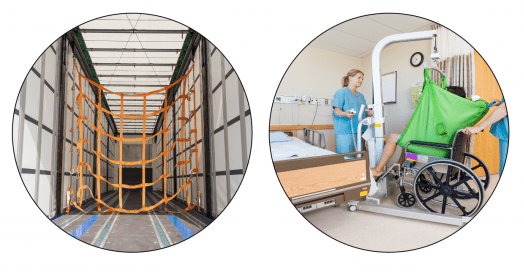How To Get the Best Patient Lift Sling Material
Leave a CommentPatient lift slings securely move individuals with mobility issues, whether due to age, injury, illness, or disability. They are designed to operate in tandem with hoist systems and provide mechanical support and lifting capabilities for patient transfer. Moreover, they are commonly used in hospitals, nursing homes, rehabilitation centers, and home healthcare environments.
Selecting the appropriate patient lift sling material ensures the patient’s comfort and contributes to the caregiver’s ease of use during transfers. It can also enhance the overall efficiency of the transfer process, promoting smoother and more secure patient movements. This article will explore the different material options and key factors to consider when selecting the best sling material.
Patient Lift Sling Material Options
Several material options are available for patient lift slings, each with distinct characteristics and benefits. Here are five of the most preferred types:
Mesh
Mesh slings are made from a lightweight, breathable material that promotes air circulation and prevents heat buildup. Their porous nature allows for improved ventilation, reducing the risk of skin irritation and discomfort. They also particularly benefit patients who sweat or require enhanced airflow during transfers.
Solid (With Breathability)
Solid slings are typically made of polyester or nylon fabric, offering a stable surface for supporting the patient’s body. They may also incorporate breathable panels or perforations to enhance airflow and prevent excessive heat or moisture buildup. This combination of a solid base with breathable elements provides support and comfort during transfers.
Polyester
Polyester slings are widely used due to their strength, durability, and ease of maintenance. They balance durability and softness, offering cushioning and stability during movements. Additionally, they are typically resistant to stretching and fraying, making them suitable for frequent use.
Padded
Padded slings have additional padding or cushioning in strategic areas, including the leg, back, and headrest, to distribute pressure more uniformly. The padding also provides a softer surface for the patient, reducing the risk of pressure sores or discomfort during patient transfers. In addition, they are typically constructed from polyester or nylon.
Non-Woven
Non-woven slings are made from bonded synthetic fibers, forming a durable, tear-resistant material. They are often used in disposable or single-use situations where hygiene is a primary concern. While they may provide less breathability, they are suitable for short-term use or frequent replacement.
Factors To Consider During the Material Selection
The right material can minimize the risk of skin irritation, pressure sores, or discomfort during transfers, enhancing the patient’s comfort and dignity. It can also optimize the transfer procedure, making it more efficient and streamlined while prioritizing the safety and well-being of everyone involved. Before selecting a patient lift sling material, the following are the most important considerations:
Comfort
The selected material should be soft, gentle, and non-irritating to the skin. Padded slings or those made from breathable fabrics like mesh can be beneficial to enhance comfort levels. Furthermore, an ergonomic design and appropriate weight distribution can reduce pressure points and the risk of discomfort or pain.
Durability
The durability of a patient lift sling is essential to ensure its longevity and cost-effectiveness. The material must withstand frequent use, washing, and the demands of the transfer process without compromising its integrity. High-quality fabrics and reinforced stitching are durability indicators, ensuring the sling can maintain its functionality over time.
Load Bearing Capacity
It is important to select a sling with a load-bearing capacity that matches or exceeds the weight of the individual being lifted. This ensures stability, reduces the risk of accidents or injuries, and provides the necessary support during movements.
Size and Shape
The size and shape of the sling should be compatible with the body dimensions and needs of the individual. It should be appropriately sized to accommodate the patient comfortably while providing optimal support and stability. Additionally, considering factors such as body contouring, headrest support, and leg positioning can further enhance the fit.
Cleaning and Maintenance
The material should be machine washable, quick-drying, and resistant to stains and odors. It should also have antibacterial properties that help eliminate bacteria and odors, creating a cleaner and more hygienic environment.
Compatibility With Lift Type
Patient lift slings should be compatible with the type of lift or hoist being used. Different materials may have specific attachment mechanisms or requirements, and selecting one designed to work with the particular lift type is important. Nonetheless, ensuring compatibility ensures the lift system’s proper functioning and enhances transfers’ safety and efficiency.
Jason Mills: The Industry-Leader for Healthcare Textile Solutions
At Jason Mills, we provide materials that meet the highest quality standards and contribute to the well-being of patients and healthcare professionals alike! Our extensive product lineup contains materials with inherent antibacterial fibers specially formulated to inhibit bacterial growth. We also have developed proprietary water-repellent finishes specifically designed for use on the skin, providing an added layer of protection and comfort.
Contact us today for more information! You can also request a quote now.




